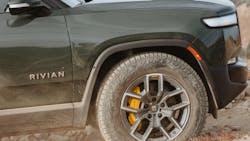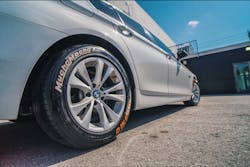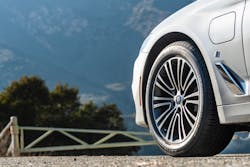Passenger Tire Sizes Are Far From ‘Topping Out’
According to the Tire & Rim Association, there are 390 P-metric/passenger tire sizes in the U.S. market. Two new 17-inch sizes, four new 18-inch sizes, five new 20-inch sizes, three new 21-inch sizes and three new 22-inch sizes — all P-metric — were introduced in 2022.
Have passenger tire size reached a saturation point? Not even close, according to most tire manufacturers and distributors. In fact, the emergence of more electric vehicles (EV) — as well as the increasing age of the U.S. vehicle population — will add more SKU complexity.David Poling, vice president, research and development and technical, Giti Tire (USA) Ltd. says his company believes that size proliferation “will continue for the foreseeable future since it has been that way for many years. There is constantly a shift to larger rim diameters, which by its very nature brings new sizes, but doesn’t eliminate the need for older sizes for vehicles that, on average, are 12 years old.
“There seems to be no incentive for the original equipment manufacturer (OEM) to limit the number of possible SKUs,” says Poling. “There are some OEMs that seem to lower speed ratings, which seems odd, but this also drives up complexity. If the market is 90% V-rated and an OEM is asking for T-rated, then we are forced to make multiple SKUs in that line.
“On the bright side, there also are OEMs that are requesting the same size for a single platform that crosses multiple vehicles. Hopefully, the need for OEMs to reduce their own complexity in cost will at least slow down the trend of size proliferation.
Apollo Tyres Ltd. doesn't believe the U.S. passenger tire market has reached saturation when it comes to sizes “as the vehicle product mix in North America continues to evolve, especially with more electric vehicles added to lineups,” according to Karl Jin, divisional head, product and pricing, PCLT, Apollo.
“For example, we just saw Cadillac introduce its all-electric Escalade IQ, which features a factory 24-inch wheel as standard equipment. While that size may be an outlier today, it is an OE fitment for an important and popular nameplate. That’s how trends begin.
“It’s not unreasonable to think that previously niche fitments could become mainstream,” says Jin. “If anything, we are on the verge of a wave of engineering and design innovation that will bring a host of different sizes to the mainstream mix.”
“We don’t believe we’ve reached the saturation point” when it comes to SKUs, says Ryan Parszik, manager, product planning, Yokohama Tire Corp. “With all the new EVs coming out in the next five years, there are going to be new requirements for these vehicles in both raw size and carrying capacity that will lead to new sizes and variations of existing sizes.”
John Wu, product strategy director, Maxxis International-USA, says Maxxis is seeing the trend toward more SKUs “persist at the original equipment level. We believe it will continue industry-wide with electrification. Packaging restraints are different with EVs, so automakers can explore different designs and may eventually need different sizes due to appearance, performance, packaging, load rating and other reasons. Some EV models even feature multiple powertrain options, which can also increase the sizing mix.
“We expect to see a continued proliferation of passenger sizes in the U.S., driven by OEMs and the expansion of trim levels,” says Rachel Swenson, senior product planner, Bridgestone Americas Inc. “At the same time, we are seeing that people are keeping their vehicles longer than they ever have, so some older sizes are sticking around longer than they would have in a previous era.”
Within existing sizes, Bridgestone continues to see “the shift to high-rim diameter sizes and we are seeing old sizes dropping at the bottom, so it’s certainly not stagnant. As a tire supplier for the OEM, the OEM approaches us for a specific size and we build a tire to meet their target. The complexity is up to the OEM. If they can dream it and someone can make it, the sky’s the limit.”
“One example” of increased complexity “is the launch of the Michelin Defender LTX M/S2 LT275/50R24, which is targeting new vehicle entries in the market,” notes Russell Shepherd, technical communications director, Michelin North America Inc., who adds that the increase in the median age of used vehicles also contributes to size proliferation and complexity. “This results in fewer sizes becoming obsolete.
“Finally, the market will become more complex because of the introduction of new standards, like C-metric tires for the commercial market and high load capacity tires, “which permit the increased load index for a given dimension compared to other tires in the market. Because they are introduced as OE fitments, there is rarely a choice (at the replacement level), other than an exact match of the tire, particularly the load index.
“The use of these new standards is growing as others remain relevant,” says Shepherd. “As a result, we expect a continued proliferation of passenger car tires in the U.S. for several years to come.”
“The U.S. market has reached a saturation point, but only in certain respects,” says Jayden Lee, Pirelli Tire North America Inc. product manager. “What we are seeing is a trend that OEMs have all but abandoned smaller rim sizes in favor of larger ones. Pirelli, as a tire OEM, has adapted to that pattern, so our focus for producing passenger tires is in line with what the market is demanding — larger, more customized tire sizes and solutions.”
While “legacy” wheel sizes, like 17 inches, remain “relatively popular, auto OEMs are pushing the envelope by pushing rim sizes as high and 23-inch and 24-inch,” says Lee. “This trend obviously has an impact on how tire OEMs, like Pirelli, respond.In addition, “the proliferation of various vehicle drivetrains, especially in the EV segment, (also) has caused growth in passenger tire sizes. With (the) addition of EVs, (passenger tire sizes have) become significantly more complex as we have to cater to diverse targets and preferences.”
“We expect continued proliferation of passenger tire sizes within our passenger product portfolio,” says Mike Park, assistant director of marketing, brand division, Tireco Inc. “Drivers such as advancements in electric and autonomous vehicles, which may have unique tire requirements, could create demand for new sizes in our existing passenger product lines. Consumer demand for specific features, such as enhanced fuel efficiency, can also lead to the development of specialized tire sales.
“OEM trim levels and OE tire size requirements can become exceedingly complex,” says Park. “With continuous advancements in vehicle technology, manufacturers are introducing more diverse models and trim levels. Each of these variations might have unique tire specifications to ensure optimal performance, safety and fuel efficiency.”
There are a number of reasons why American Kenda Rubber Industrial Co. Ltd. believes passenger tire sizes have not reached a saturation point, says Brandon Stotsenburg, vice president, automotive division, Kenda.
“First, as vehicle lifecycle continues to expand, older sizes remain in the market far longer than past generations, while new sizes with larger wheel diameters continue to grow. Second, as the market will be in a transition from internal combustion engine to EV applications, there is going to be an increasing number of SKUs that may offer the same size, but will vary in speed rating, load capacity and construction to optimize for either type of vehicle. Third, OEMs will continue to follow consumer trends for larger wheel diameters, while optimizing chassis performance for the vehicle, with a focus on projected fuel economy and for EV vehicles, rolling resistance to extend range.”
Auto manufacturers will continue to offer additional trim options, “as their research shows their target audience desires promised applications,” says Stotsenburg. “As an example, Ford currently offers 19 options on the 2023 Bronco — not including the Sport — with six OE tire fitments. Of those OE options, four are metric sixes, while two are light truck designations. All of the OE options have aftermarket upgrades for plus one and plus two fitments, which will be pursued, depending on intended vehicle use.”
Chris Tolbert, director of sales for Trimax Tire, expects to see continued proliferation of sizes. "but we prefer to think of it as the proliferation of sizes in sub-categories," such as all-season, UHP summer, UHP all-season, EV, all-weather and winter in the passenger tire segment. And as the EV market evolves, "this could create additional sizes adapted to lower rolling resistance, braking, handling, noise and vehicle weight."
Jay Lee, product planning director for Nexen Tire America Inc., says auto manufacturers "are expanding their trims to maximize vehicle sales and satisfy various consumer demands. In the case of the top-tier trim levels, vehicle performance, including engine power, is maximized. Therefore, the tires installed on these models are larger and wider compared to the base model trims. Additionally, with the introduction of EV models, there is a growing need for more and larger tires."
Product proliferation isn’t exclusive to the tire industry, says Joaquin Gonzalez Jr., president of Tire Group International LLC. “If Baskin-Robbins was starting up today, it would need more than 31 flavors! Over the last 10 to 15 years, consumers have become accustomed to a certain level of ‘have it your way,’ when it comes to purchasing vehicles — hence there are so many trim packages in a single vehicle. I do not see this trend slowing down.
“The passenger tire segment is constantly evolving. Factors like vehicle diversity, technological advances, regulatory changes and market trends are some of the key drivers in size proliferation. As new sizes, specs or treads come onboard, they ultimately end up replacing existing ones.
“So we do see continued evolution,” says Gonzalez. "A clear example is the EV tire market. As those vehicles become more mainstream, you will begin to see more application-specific tires for that segment.”
The market is “not even close” to reaching its SKU limit, says Phillip Kane, CEO of Turbo Wholesale Tires. “With EV mandates looming and a continued march by manufacturers away from cars to truck and CUV platforms, vehicle OEMs will continue to create new sizes, both as a necessity and as a means of differentiating themselves from competitors. Further expansion into EVs, plus moves that we are seeing around slightly more aggressive tires in CUV and less aggressive tires in light trucks, are all driving more SKUs.
“We’re just starting to see the impact of EVs on tires,” says Kane. “As new and different electric vehicles focused on new and different end user benefits are introduced, expect tiremakers to have to respond with new and different tires to help deliver the outcomes that consumers are after — particularly as it relates to such factors as ride height, comfort, stability, noise, miles per charge, wear, handling and certain safety-related metrics.
“Also with the average vehicle age in the U.S. now at 12.2 years and growing, old sizes are not phasing out,” he adds.
“If you compare today’s sizes, they are much more numerous than 30 years ago,” says Ara Tchaghlassian, CEO of Wholesale Tire Distributors. “Without a doubt, we will see continued expansion of sizes and rim diameters, widths, load carrying capacities and many other variables.
“With the growing popularity of SUVs, the use of autonomous vehicles on the horizon, the many new entrants into the vehicle manufacturing space and the rapidly changing preferences of the motoring public, we are sure to see more complexity.”
About the Author
Mike Manges
Editor
Mike Manges is Modern Tire Dealer’s editor. A 28-year tire industry veteran, he is a three-time International Automotive Media Association Award winner, holds a Gold Award from the Association of Automotive Publication Editors and was named a finalist for the prestigious Jesse H. Neal Award, the Pulitzer Prize of business-to-business media, in 2024. He also was named Endeavor Business Media's Editor of the Year in 2024. Mike has traveled the world in pursuit of stories that will help independent tire dealers move their businesses forward. Before rejoining MTD in 2019, he held corporate communications positions at two Fortune 500 companies and served as MTD’s senior editor from 2000 to 2010.




